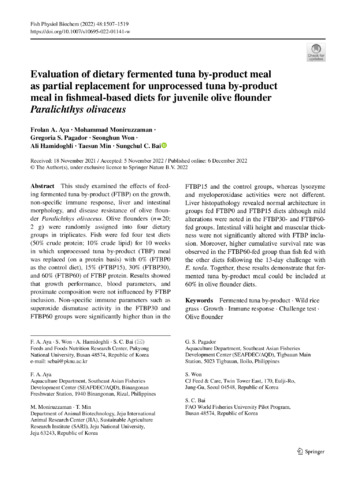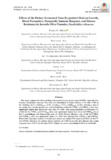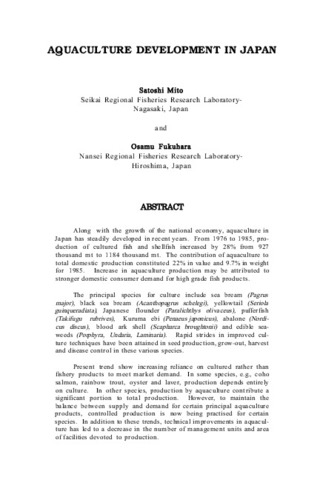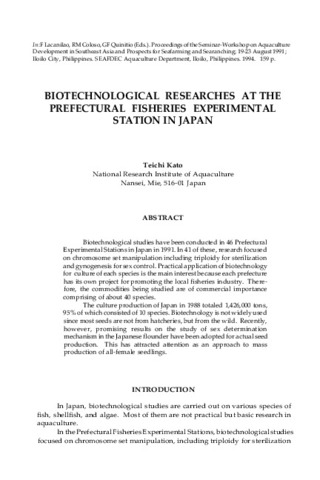Evaluation of dietary fermented tuna by-product meal as partial replacement for unprocessed tuna by-product meal in fishmeal-based diets for juvenile olive flounder Paralichthys olivaceus

ຄົ້ນຫາ / ເປີດ
ວັນທີ
2022-12-06ຜູ້ຂຽນ
Page views
378Metadata
ເບິ່ງບັນທຶກລາຍລະອຽດລາຍການCited times in Scopus
Share
ບົດຄັດຫຍໍ້
This study examined the effects of feeding fermented tuna by-product (FTBP) on the growth, non-specific immune response, liver and intestinal morphology, and disease resistance of olive flounder Paralichthys olivaceus. Olive flounders (n = 20; 2 g) were randomly assigned into four dietary groups in triplicates. Fish were fed four test diets (50% crude protein; 10% crude lipid) for 10 weeks in which unprocessed tuna by-product (TBP) meal was replaced (on a protein basis) with 0% (FTBP0 as the control diet), 15% (FTBP15), 30% (FTBP30), and 60% (FTBP60) of FTBP protein. Results showed that growth performance, blood parameters, and proximate composition were not influenced by FTBP inclusion. Non-specific immune parameters such as superoxide dismutase activity in the FTBP30 and FTBP60 groups were significantly higher than in the FTBP15 and the control groups, whereas lysozyme and myeloperoxidase activities were not different. Liver histopathology revealed normal architecture in groups fed FTBP0 and FTBP15 diets although mild alterations were noted in the FTBP30- and FTBP60-fed groups. Intestinal villi height and muscular thickness were not significantly altered with FTBP inclusion. Moreover, higher cumulative survival rate was observed in the FTBP60-fed group than fish fed with the other diets following the 13-day challenge with E. tarda. Together, these results demonstrate that fermented tuna by-product meal could be included at 60% in olive flounder diets.
Keywords
Fermented tuna by-product Wild rice grass Growth Immune response Challenge test Olive flounderSuggested Citation
Aya, F., Moniruzzaman, M., Pagador, G. E., Won, S., Hamidoghli, A., Min, T., & Bai, S. C. (2022). Evaluation of dietary fermented tuna by-product meal as partial replacement for unprocessed tuna by-product meal in fishmeal-based diets for juvenile olive flounder Paralichthys olivaceus. Fish Physiology and Biochemistry , 48(6), 1507-1519. https://doi.org/10.1007/s10695-022-01141-w
ວິຊາ
Taxonomic term
Collections
- AQD Journal Articles [1248]
Related items
Showing items related by title, author, creator and subject.
-
Effects of the dietary fermented tuna by-product meal on growth, blood parameters, nonspecific immune response, and disease resistance in juvenile olive flounder, Paralichthys olivaceus
Oncul, Fatma Ozgun; Aya, Frolan; Hamidoghli, Ali; Won, Seonghun; Lee, Geon; Han, Kyoung R.; Bai, Sungchul C. (World Aquaculture Society, 2019)This study evaluated the effects of dietary fermented tuna by‐product meal (FTBM) in juvenile olive flounder, Paralichthys olivaceus. Five diets were formulated to replace fishmeal (FM) with FTBM at 0% (FTBM0), ... -
Aquaculture development in Japan
Mito, Satoshi. (Aquaculture Department, Southeast Asian Fisheries Development Center, 1988)Along with the growth of the national economy, aquaculture in Japan has steadily developed in recent years. From 1976 to 1985, production of cultured fish and shellfish increased by 28% from 927 thousand mt to 1184 thousand ... -
Biotechnological researches at the Prefectural Fisheries Experimental Station in Japan
Kato, Teichi. (Aquaculture Department, Southeast Asian Fisheries Development Center, 1994)Biotechnological studies have been conducted in 46 Prefectural Experimental Stations in Japan in 1991. In 41 of these, research focused on chromosome set manipulation including triploidy for sterilization and gynogenesis ...



